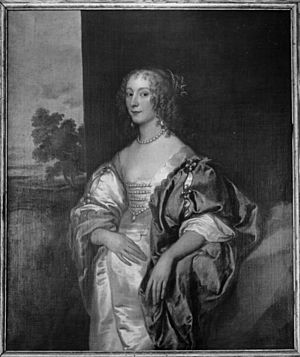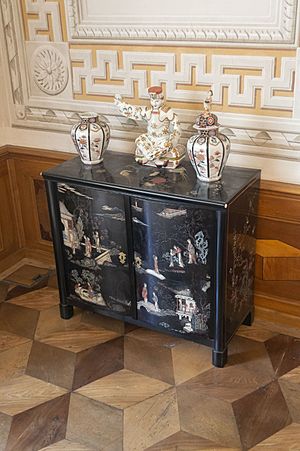Molly Verney facts for kids
Quick facts for kids
Molley Verney
|
|
|---|---|
| Born | 1 January 1675 |
| Died | 1 February 1696 (aged 21) |
| Occupation | Genteel Lady |
| Known for | Having the first recorded instance of using Japan as a verb in 1683 |
| Spouse(s) | Mr.Kelyng |
Mary Verney (1675 – February 1696) was also known as Molly or Mall Klenyg. She was a British noblewoman. She is famous for being the first person recorded to use the word "Japan" as a verb in English, back in 1683.
Contents
Mary Verney's Life Story
Mary Verney was born in 1675. Her parents were Mary Abell (1641-1715) and Edmund Verney (1636-1688). Her grandparents were Mary Blacknall (1616-1650) and Ralph Verney (1613-1696).
Mary had two brothers, Ralph (who died in 1686) and Edmund (who died in 1690). After their deaths, Mary became the heir to the West Claydon estate. The Verney family spent a lot of money on Mary. They dressed her in fancy silk dresses from a young age, starting around 1679.
Schooling and Family Changes
In 1682, Mary traveled to London with her father, Edmund Verney. She wanted to attend Gorges School. This was a boarding school for upper-class young women. It was located on Cheyne Walk (and was later taken down in 1762). There, Mary took dancing and handicraft lessons. These lessons were taught by Josias Priest.
In 1688, her father passed away. He left the family with many debts. Mary's guardian, Ralph Verney (who died in 1696), was not eager to pay these debts. This meant Mary's household expenses had to be cut back.
By 1690, Mary became the main heir to the family estate. This was because her mother suffered from an illness that affected her mood. Because of this, Mary became more active in English society. She was seen as a good candidate for marriage.
Marriage and Later Life
In 1692, her grandfather Ralph suggested she marry Robert Dormer. He was a gentleman, the son of a lawyer and landowner from Quainton. However, Mary turned down this offer. Instead, she married the son of John Kelyng in 1693. John Kelyng was also a well-known lawyer and landowner. Mary married him in secret. In June 1693, she moved to live with John Kelyng's wife in 'Fisher Street in Red Lion square'.
From 1694 to 1696, Mary worked to get her family's approval for her marriage. Her guardian, now Baronet Ralph Verney, was the main person she needed to convince. With help from the Stewkely family (her Aunt Gardina and cousin Cary Stewkeley), Mary eventually got permission. The Stewkely family argued that Mary was not marrying just for money. However, Mary did not inherit her family estate. It went to the Abell family instead. Mary gave birth but died shortly after in February 1696. Her baby daughter, also named Mary, died three months later.
Women and Japanning
Japanning is a type of decorative art. It involves applying a hard, shiny lacquer-like finish to objects. This art first came to Europe in 1610 in the Netherlands. England had close trade ties with the Netherlands. So, it's likely they traded objects with this type of finish. By 1679, it became a popular craft among English tradesmen. They worked for wealthy English families.
In the 17th century, people didn't know much about Asian geography. So, China, Japan, and Indian art styles were often mixed up. This led to a style called Chinoiserie. It featured both real and imagined images of the "Indian taste." Many of these images came from travel stories by European explorers. Others came from goods imported by the EIC and private merchants. Books by travelers like Marco Polo (1254-1324) and Engelbert Kaempfer (1651 -1716) also helped people learn more about Asian countries. These books often included maps and drawings.
Japanning as a Skill for Women
Women were not the main audience for Japanning at first. But more women were spending time at home. Writers like Hannah Woolley in 1675 encouraged women to "adorn" rooms with decorative "fancies." This helped introduce women to the craft.
Mary Verney started learning "to Jappan" in 1683. Her father, Edmund, believed this skill would help her. He thought it would make her more suitable to be placed in "the household of some lady of quality." He hoped Japanning would help her pay for her living and wages. Edmund Verney paid 40 shillings for Mary to learn this craft in London.
Her father wrote to her in 1683: "I find you have a desire to learn Jappan, as you call it, and I approve it; and so I shall of any thing that is good and virtuous [. . .] for I admire all accomplishments that will render you considerable and lovely in the sight of God and man."
Real Kakiemon porcelain and lacquer were very rare. So, people often bought homemade versions. Amateurs and cabinet makers offered these. In 1689, the Duke of Hamilton told his wife that "for my part I think a counterfeit one looks as well." He asked if she would take such a piece.
"Lac," as it was called then, was hard to find. Its rarity made individual lacquerware items very expensive. This led to cabinetmakers and upholsterers making imitation pieces. Real Japanese lacquer is made from the sap of the Toxicodendron vernicifluum tree. This tree did not grow in Europe. So, furniture makers started making fake lacquers. They used spirit varnish and oil resins. These became known as "japanning."
The trend grew stronger during the reign of Mary II. She had a large porcelain collection at Hampton Court Palace from 1689-1694. This collection was inspired by fashionable Dutch interior designs. By 1710, Japanning was seen as a suitable activity for women. Writers like Alexander Pope even mentioned it, appealing to a female audience.
Popularity of Japanning
From 1680 to 1760, Japanning was considered a "genteel" (polite and respectable) hobby. It was like needlework. Applying decorative patterns to wooden surfaces was seen as a good pastime for young women.
Many instruction manuals were published between 1697 and 1766. These books taught young women how to "Jappan." They helped establish the art as one for women. These design books were often for beginners. They provided fantastical "copy and paste" designs. New Japanners could use these to varnish and "paint" objects. These books also became popular on their own for their Oriental images.
These fake lacquer techniques were sometimes used on fabrics. But they became very popular by the 18th century. You can find them on cabinets, tea-trays, powderboxes, and drawers. Some of these designs were so different from the original Asian art. They can be seen as an early form of Japonaiserie. Some common designs included landskips with woods, cottages, rivers, trees, hills, the sun, moon, and stars.



